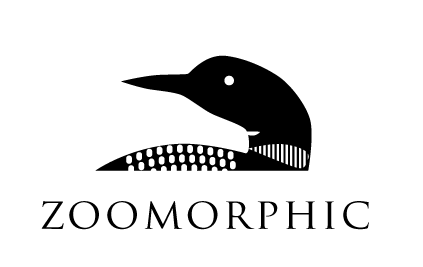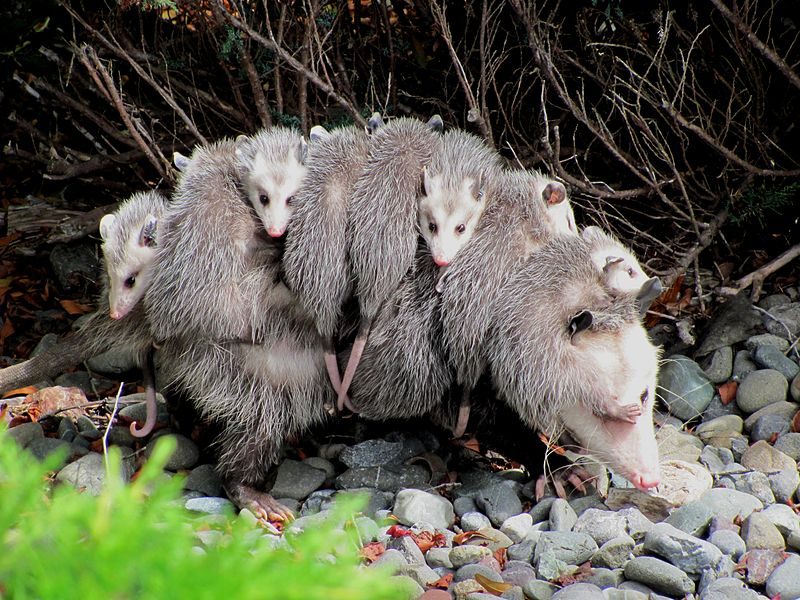by Nadja Lubiw-Hazard
Opossums have thirteen nipples. I was unhappy with this asymmetry, picturing the two even rows of six and that lonely, unpaired, thirteenth nipple, until I discovered that the nipples form a circle, with a single one in the middle. A flower of nipples. How lovely, I thought.
I have been reading about opossums since I saw one last week. The Virginia Opossum, Didephis virginiana, is typically found living in woody vegetation along rivers and streams. My opossum, the one that I spotted as I was walking home from the bus-stop on the corner of Victoria Park and Bassett Avenue in Toronto, has traded in deciduous woodland for urban life.
It was dusk. In the imagination of my memory there was fog, low lying and wispy. I heard a sound, the scratch of a claw against pavement perhaps, and the swirling fog parted to reveal something moving, something low to the ground at the edge of the bungalow on the corner. Rat-like, but too big to be a rat; the size of a cat, but too low to the ground. Raccoon? But no, this animal had a coat that shimmered silver in the light of the streetlamp, a naked tail snaking behind a teardrop-shaped body. Opossum!
She paused and lifted her small pointed snout, sniffing the night air, before waddling away and disappearing into the darkness. I was enchanted.
I read on: the joeys wriggle their way up from the birth canal to the pouch, sensing and moving away from gravity, grasping on to their mother’s fur with their minuscule deciduous claws. Just like the discovery of the flower of nipples, I am delighted to discover the temporary baby claws. Only two weeks since conception – the shortest gestation of any mammal – and the tiny opossums, honeybee-sized and hairless, have developed rudimentary claws for the four minute journey to the pouch, claws that will be shed and replaced later by permanent ones.
I already knew that opossums have prehensile tails, but I learn that they can carry bundles of grasses in a coil of their tail. I knew too, that males have a bifid penis, like a forked reptilian tongue, and females have a matching doubled up reproductive tract, with two vaginas and two uteri. But there are new discoveries: opossums have fifty teeth; they are resistant to rabies and immune to snake venom; most are furred in grey or black, but there are rare cinnamon phase opossums with reddish-brown fur. A two-pronged penis! Fifty teeth! Cinnamon fur!
And of course there is the opossum’s pouch, the defining feature of any marsupial, lined with amber-coloured fur, where the joeys will live for 3 months, permanently attached to the same teat for the first sixty days.
*
I have an untamed exuberance for animals of all kinds. As I sit at my desk writing about opossums on my computer in a darkened room, a centipede scuttles down the wall to the floor and then freezes. I have a visceral reaction of fear to the centipede’s sudden appearance: to the rapid vertical descent I have just witnessed; to the multitude of darkly-striped, antenna-like legs on a creature that appears to be as large as a mouse. But after my initial shock subsides, I become curious. I watch as the centipede curls around and starts grooming each leg meticulously from the base to the tip, working down the row of fifteen legs on the left side of the body, sliding each leg through the mouth forcipules. I start to wonder: does he/she always groom the left side first? What is life like, moving about with all those legs? Where does this centipede actually live – is there a centipede lair somewhere in my home?
Animals bring me to wonder. What a lovely word ‘wonder’ is. An adjective or noun for marvellous things and miracles. A verb of astonishment and amazement, of curiosity. Wouldn’t it be nice if we reverted back to the Middle English way of saying “It wonders me that” instead of simply “I wonder why?” It wonders me that centipedes have so many legs.
The presence of this myriad-legged, nocturnal predator reminds me that my home is dug into the earth, that nature dwells within. There is no line that separates the city and the wild; nature is part of our daily lives, with us and within us, all the time.
It seems like an extraordinary gift that I can watch a coyote lope in a single-minded straight line across the quarry lands at Gerrard and Clonmore as I pack my groceries into the hatch of my car, that I can step outside to walk the dog and hear the hoarse keeeeee-arr of a red-tailed hawk soaring above my neighbour’s towering white pine, that if I pay attention, I can be a part of this wild life that exists here in my city.
Sometimes these wild moments are more fantastical than others: climbing up a steep and muddy ridge in Highland Creek Park last fall I was startled by a huffing sound, and I looked up to see a white-tailed deer standing, silhouetted against the pink clouds, his branching antlers reaching up like two giant, thin-fingered hands to embrace the sky. We were caught off-guard by each other’s presence, startled into a shared stillness. I stared up at him, awestruck and breathless. I was lifted outside of the incessant chatter that constantly fills my mind; I had a moment of pure and vast openness that contained simply the smell of musk, the pink sky and the twigged antlers, the blackness of the deer’s eyes. The boundary that surely exists between a stag and a human fell away. When the spell broke he turned and flashed his white tail at me before bounding away into the woods. I leapt after him, ready to gallop through the forest with him, to feel the give of the muddy ground under my hooves, the heaviness of those antlers anchored to my skull.
*
I saw my opossum again late one night, a few weeks ago. She was lying on the road at the edge of the curb. I was sure that she had been hit by a car, or mauled by a dog. I dashed forward, prepared to witness carnage. She was curled on her side, her scaly tail wrapped up to her nose, her mouth open in a half-grin, half-grimace, exposing as many of her fifty teeth as possible. I knelt down for a better look. Her small dark eyes were open, shining in the moonlight. A spray of whiskers bloomed from her pointed snout. Her ears were like the dark leaves of an exotic plant, cupped and leathery, tattered at the edges. There was no blood, no signs of trauma. Was she dead?
Opossums, despite their reputation for viciousness, are quiet and gentle. When they are frightened they hide; when they are threatened they crouch down low and try to intimidate by opening their mouth wide to show off all their sharp teeth. They will hiss, growl, and screech. But it’s a bluff. And if the bluff fails, they fall unconscious, feigning death in the hopes that a dead opossum will be less appealing than a living one.
Could my opossum have fainted in fright? Her front paws were tucked against her chest, the right clutched tightly to the left, as if she has witnessed a great horror. I have read that it is impossible to revive an opossum from this state, but I was still cautious as I reached out to touch her. All those jagged teeth, lined up like the blade on a handsaw, were intimidating.
The guard hair on her grey pelt looked like it would feel coarse, but her fur was luxuriant, soft and thick under my hand. Her body was warm to the touch, but I still wasn’t convinced that she was alive. She remained completely immobile and unresponsive to my touch. I crouched back on my heels, watching to see if her chest was rising and falling, but it was hard to see in the shadows. Maybe her breathing was slow and shallow; it would make sense if she was in a catatonic state. I rested my open hand lightly on her chest. I could smell her pungent odour: musky and fragrant, tinged with rot. This too is part of playing dead – opossums release a foul-smelling liquid from their anal glands, a smell that mimics a corpse and wards off predators that prefer live prey. A few more seconds passed. A single car drove by. A sudden thought occurred to me. What if she was dead, but she had babies in her pouch? I have read about live baby opossums being rescued from the pouch of dead, hit-by-car opossums, raised and released back into the wild. I leaned forward and lifted the back leg of my opossum to see the abdomen. There it was: a slit on her belly – the opening to a pouch! What if there were hairless, jellybean-sized baby opossums hidden within? The edge of the pouch had a thickened ring, like a rubber band. I pulled it gently open and peeked inside. The pouch was empty. I felt both relief and disappointment.
I waited again, palm against her chest, until I felt the slight of my hand as her ribcage expanded with an inhale. She was alive! I stayed a few more minutes, sitting on the edge of the curb, watching her from a short distance away. I wished her well, wished for her to be free from harm.
When I finally left, after I had lifted her up by the scruff of the neck and tucked her out of sight under a thick hedge, safe and sheltered, away from the road, I practically skipped home. I had been brought to wonder, astonished and amazed, by this encounter with a wild marsupial. When I returned an hour later to check on her, she was gone.
Several weeks have passed since my last opossum encounter. I think about her, worry about her, my city opossum. It’s snowy today, and the temperature has dropped below zero. Where has she holed up? Are her hairless ears frostbitten? How will she find enough food to survive the winter? And when will I see her again?
Nadja Lubiw-Hazard is a Toronto-based writer, an educator and a veterinarian. She holds a Post Graduate Certificate in Creative Writing from the Humber School for Writers and a Doctor of Veterinary Medicine from the University of Guelph. Nadja is a vegan and an animal advocate; she has volunteered for many years with Zoocheck, an animal protection group in Canada. She works part time as a veterinarian at the Toronto Humane Society. Her work has been published in Room, Canthius, Understorey and The Dalhousie Review. Her first novel, The Nap-Away Motel will be published in spring 2019 by Palimpsest Press. You can find her online at www.nmlhazard.com.
Image by Specialjake, CC BY-SAhttps://creativecommons.org/licenses/by-sa/3.0/ 3.0 https://commons.wikimedia.org/wiki/File:Didelphis_virginiana_with_young.JPG

